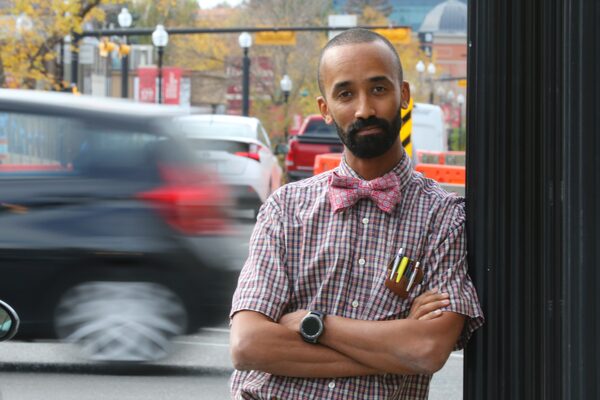
Uber driver Binyam Asress recently decided to take a hiatus from driving to focus on building his life coaching and consulting business.Dave Chidley/The Globe and Mail
Prior to the pandemic, it was never difficult for Durham, Ont.-based Uber driver Pete Needham to find customers.
“I was making huge amounts of money pre-pandemic, it was crazy,” says Mr. Needham, 51. “You turn the thing on, and you barely get a bathroom break.”
That all changed in March, 2020, when the pandemic upended life for front line workers of all types. Now, more than a year and half later, driving for a taxi or rideshare company still isn’t quite the same as it once was.
Today, Mr. Needham predicts that rider traffic is about 40 to 45 per cent of pre-pandemic levels. Over the past year and a half, however, he says the industry has been on a roller-coaster ride tied to COVID-19 case numbers and varying reopening phases.
“As soon as the Prime Minister [Justin Trudeau] made the announcement to tell everybody to come home, everything shifted,” Mr. Needham explains, adding that his clientele seemingly changed overnight, from everyday commuters to front-line workers. “It wasn’t really the public per se, it was mostly nurses and front-line workers. They felt it was safer to take an Uber home [than public transit].”
Mr. Needham adds that front-line health care workers typically entered his vehicle in their work-issued personal protective equipment (PPE), and often fell asleep in the back seat. While ridership was way down, he says he and other Uber drivers were able to make up for the slowdown thanks to skyrocketing demand from the company’s food delivery platform, Uber Eats.
Things finally started to resemble normality more closely in the summer of 2020, following the easing of some restrictions. “That’s when I saw people coming out from hibernation,” he says, adding that the return of regular customers brought new challenges. Rideshare drivers are responsible for sanitizing their vehicles after each trip, and enforcing a mask requirement, which Mr. Needham says is met occasionally with resistance, and even disdain.
He says teenagers were the ones most likely to approach his vehicle without a mask on, and, on occasion, adults who identify as anti-maskers. In those instances, he typically rolls down his window before they enter to politely remind them to put one on. He also offers a disposable mask to those who don’t have one handy. If they still refuse, however, he simply cancels the ride and drives away. There was only one time during the pandemic that Mr. Needham felt unsafe.
“One guy was racist; he had his mask on at first, but then he became very belligerent, and the mask dropped to his chin,” as he continued to yell, he says. ”As I got closer to his place the volume started to get higher … I got him to his place, but after that I had to call the Uber Hotline and explain what I just went through … Maybe he was just having a bad day, but nobody should have to put up with that.”

Mr. Asress adds that he began driving for Uber both as a way to make money and to connect with people in his community.Dave Chidley/The Globe and Mail
Mr. Needham emphasizes that this particular interaction was an outlier, adding that customers have been polite and respectful of the new rules generally.
“Here in Calgary, I haven’t had any experiences like that,” says Binyam Asress, who started driving for Uber in the summer of 2019. “Even if they were against the measures, they were still compliant, they were still very respectful about it.”
Mr. Asress adds that he began driving for Uber both as a way to make money and to connect with people in his community. While he says the opportunity to switch over to Uber Eats during the pandemic was a “saving grace” for many drivers – including himself – he recently decided to take a hiatus from driving to focus on building his life coaching and consulting business.
“I still would like to drive for Uber in a different context, not where I’m depending on it for my income, but more so where I can continue to be able to connect with people along the way,” he says.
While transitioning careers is relatively simple for those using ridesharing apps, taxi drivers – who invest thousands of dollars each year into their business – didn’t have that opportunity.
“The pandemic hit, and then there was no work,” says Thomas Spandis, who has been driving a taxi in Toronto for Co-Op Cabs for 33 years. “It’s like someone pulled the rug right from underneath you.”
Mr. Spandis explains that licensed taxi drivers are required to spend upwards of $10,000 each year on commercial auto insurance alone – and another $1,000 for a Toronto Taxicab License – not to mention the cost of fuelling and maintaining the vehicle itself. He adds that such constraints make it a difficult business in a typical year, but when ridership plummeted at the start of the pandemic, it was nearly impossible to make ends meet.
“You go out at 5:30 in the morning, come back at six or seven o’clock in the evening, and you’ve only made $50,” he says. “That lasted over a year, and that really put a strain on my income.”
Mr. Spandis adds that ridership is back up, but has yet to reach pre-pandemic levels. With more people working from home, he fears it never will. However, with vaccination levels increasing, daily new cases remaining steady, and a provincial vaccine passport system on its way, he is hopeful that things will only get better.
In the meantime, he strongly encourages the municipal government to re-evaluate some of those fees, and provide more support to the city’s cab drivers.
“The pandemic just put more pressure on the backs of the cab drivers,” he says. “Uber and Lyft will not kill us; the insurance companies will.”